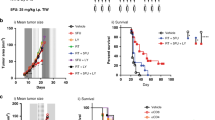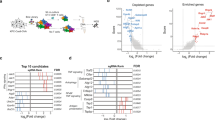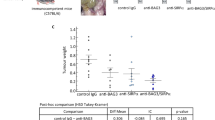Abstract
Pancreatic ductal adenocarcinoma (PDAC) is a highly aggressive neoplasm characterized by a marked fibro-inflammatory microenvironment1, the presence of which can promote both cancer induction and growth2,3,4. Therefore, selective manipulation of local cytokines is an attractive, although unrealized, therapeutic approach. T cells possess a unique mechanism of p38 mitogen-activated protein kinase (MAPK) activation downstream of T cell receptor (TCR) engagement through the phosphorylation of Tyr323 (pY323). This alternative p38 activation pathway is required for pro-inflammatory cytokine production5,6. Here we show in human PDAC that a high percentage of infiltrating pY323+ T cells was associated with large numbers of tumor necrosis factor (TNF)-α− and interleukin (IL)-17–producing CD4+ tumor-infiltrating lymphocytes (TILs) and aggressive disease. The growth of mouse pancreatic tumors was inhibited by genetic ablation of the alternative p38 pathway, and transfer of wild-type CD4+ T cells, but not those lacking the alternative pathway, enhanced tumor growth in T cell–deficient mice. Notably, a plasma membrane–permeable peptide derived from GADD45-α, the naturally occurring inhibitor of p38 pY323+ (ref. 7), reduced CD4+ TIL production of TNF-α, IL-17A, IL-10 and secondary cytokines, halted growth of implanted tumors and inhibited progression of spontaneous KRAS-driven adenocarcinoma in mice. Thus, TCR-mediated activation of CD4+ TILs results in alternative p38 activation and production of protumorigenic factors and can be targeted for therapeutic benefit.
This is a preview of subscription content, access via your institution
Access options
Subscribe to this journal
Receive 12 print issues and online access
$209.00 per year
only $17.42 per issue
Buy this article
- Purchase on Springer Link
- Instant access to full article PDF
Prices may be subject to local taxes which are calculated during checkout




Similar content being viewed by others
References
Neesse, A. et al. Stromal biology and therapy in pancreatic cancer. Gut 60, 861–868 (2011).
Coussens, L.M., Zitvogel, L. & Palucka, A.K. Neutralizing tumor-promoting chronic inflammation: a magic bullet? Science 339, 286–291 (2013).
Mantovani, A., Allavena, P., Sica, A. & Balkwill, F. Cancer-related inflammation. Nature 454, 436–444 (2008).
Grivennikov, S.I., Greten, F.R. & Karin, M. Immunity, inflammation and cancer. Cell 140, 883–899 (2010).
Salvador, J.M. et al. Alternative p38 activation pathway mediated by T cell receptor–proximal tyrosine kinases. Nat. Immunol. 6, 390–395 (2005).
Alam, M.S. et al. Counter-regulation of T cell effector function by differentially activated p38. J. Exp. Med. 211, 1257–1270 (2014).
Salvador, J.M., Mittelstadt, P.R., Belova, G.I., Fornace, A.J.J. & Ashwell, J.D. The autoimmune suppressor Gadd45-α inhibits the T cell alternative p38 activation pathway. Nat. Immunol. 6, 396–402 (2005).
Steele, C.W. et al. Exploiting inflammation for therapeutic gain in pancreatic cancer. Br. J. Cancer 108, 997–1003 (2013).
Kleeff, J. et al. Pancreatic cancer microenvironment. Int. J. Cancer 121, 699–705 (2007).
Özdemir, B.C. et al. Depletion of carcinoma-associated fibroblasts and fibrosis induces immunosuppression and accelerates pancreas cancer with reduced survival. Cancer Cell 25, 719–734 (2014).
Rao, C.V. et al. Inhibition of pancreatic intraepithelial neoplasia progression to carcinoma by nitric oxide–releasing aspirin in p48Cre/+-LSL-KrasG12D/+ mice. Neoplasia 14, 778–787 (2012).
Mayorek, N., Naftali-Shani, N. & Grunewald, M. Diclofenac inhibits tumor growth in a murine model of pancreatic cancer by modulation of VEGF levels and arginase activity. PLoS ONE 5, e12715 (2010).
Jirmanova, L., Giardino Torchia, M.L., Sarma, N.D., Mittelstadt, P.R. & Ashwell, J.D. Lack of the T cell–specific alternative p38 activation pathway reduces autoimmunity and inflammation. Blood 118, 3280–3289 (2011).
Takagi, K., Takada, T. & Amano, H. A high peripheral microvessel density count correlates with a poor prognosis in pancreatic cancer. J. Gastroenterol. 40, 402–408 (2005).
Collisson, E.A. et al. Subtypes of pancreatic ductal adenocarcinoma and their differing responses to therapy. Nat. Med. 17, 500–503 (2011).
Mathew, E. et al. Dosage-dependent regulation of pancreatic cancer growth and angiogenesis by hedgehog signaling. Cell Rep. 9, 484–494 (2014).
Liu, C.Y. et al. M2-polarized tumor-associated macrophages promoted epithelial-mesenchymal transition in pancreatic cancer cells, partially through TLR4/IL-10 signaling pathway. Lab. Invest. 93, 844–854 (2013).
Raczkowski, F. et al. The transcription factor interferon regulatory factor 4 is required for the generation of protective effector CD8+ T cells. Proc. Natl. Acad. Sci. USA 110, 15019–15024 (2013).
Ben-Baruch, A. The tumor-promoting flow of cells into, within and out of the tumor site: regulation by the inflammatory axis of TNF-α and chemokines. Cancer Microenviron. 5, 151–164 (2012).
Hingorani, S.R. et al. Trp53R172H and KrasG12D cooperate to promote chromosomal instability and widely metastatic pancreatic ductal adenocarcinoma in mice. Cancer Cell 7, 469–483 (2005).
Bulavin, D.V., Kovalsky, O., Hollander, M.C. & Fornace, A.J.J. Loss of oncogenic Hras-induced cell cycle arrest and p38 mitogen-activated protein kinase activation by disruption of Gadd45a. Mol. Cell. Biol. 23, 3859–3871 (2003).
Noguchi, H. et al. A new cell-permeable peptide allows successful allogeneic islet transplantation in mice. Nat. Med. 10, 305–309 (2004).
Matsushita, M. et al. A high-efficiency protein transduction system demonstrating the role of PKA in long-lasting long-term potentiation. J. Neurosci. 21, 6000–6007 (2001).
Zhang, Y. et al. CD4+ T lymphocyte ablation prevents pancreatic carcinogenesis in mice. Cancer Immunol. Res. 2, 423–435 (2014).
Sato, E. et al. Intraepithelial CD8+ tumor-infiltrating lymphocytes and a high CD8+/regulatory T cell ratio are associated with favorable prognosis in ovarian cancer. Proc. Natl. Acad. Sci. USA 102, 18538–18543 (2005).
Lin, W.W. & Karin, M. A cytokine-mediated link between innate immunity, inflammation and cancer. J. Clin. Invest. 117, 1175–1183 (2007).
Park, E.J. et al. Dietary and genetic obesity promote liver inflammation and tumorigenesis by enhancing IL-6 and TNF expression. Cell 140, 197–208 (2010).
Grivennikov, S.I. et al. Adenoma-linked barrier defects and microbial products drive IL-23/IL-17–mediated tumor growth. Nature 491, 254–258 (2012).
Egberts, J.H. et al. Anti–tumor necrosis factor therapy inhibits pancreatic tumor growth and metastasis. Cancer Res. 68, 1443–1450 (2008).
Waterston, A.M. et al. TNF autovaccination induces self anti-TNF antibodies and inhibits metastasis in a murine melanoma model. Br. J. Cancer 90, 1279–1284 (2004).
McAllister, F. et al. Oncogenic Kras activates a hematopoietic-to-epithelial IL-17 signaling axis in preinvasive pancreatic neoplasia. Cancer Cell 25, 621–637 (2014).
Waetzig, G.H., Seegert, D., Rosenstiel, P., Nikolaus, S. & Schreiber, S. p38 mitogen-activated protein kinase is activated and linked to TNF-α signaling in inflammatory bowel disease. J. Immunol. 168, 5342–5351 (2002).
Wagner, E.F. & Nebreda, A.R. Signal integration by JNK and p38 MAPK pathways in cancer development. Nat. Rev. Cancer 9, 537–549 (2009).
Germano, G. et al. Role of macrophage targeting in the antitumor activity of trabectedin. Cancer Cell 23, 249–262 (2013).
Dutko, F.J. & Oldstone, M.B. Genomic and biological variation among commonly used lymphocytic choriomeningitis virus strains. J. Gen. Virol. 64, 1689–1698 (1983).
Hingorani, S.R. et al. Preinvasive and invasive ductal pancreatic cancer and its early detection in the mouse. Cancer Cell 4, 437–450 (2003).
Bosman, F.T., Carneiro, F., Hruban, R.H. & Theise, N.D. in Pathology and Genetics of Tumours of the Digestive System 4th edn. (eds. Hamilton, S.R. & Aaltonen, L.A.) (IARC Press, 2010).
Sobin, L.H., Gospodarowicz, M.G. & Wittekind, C. TNM Classification of Malignant Tumours 7th edn. (Wiley-Blackwell, 2009).
Acknowledgements
We thank J. Scheuerer, M. Clauter, B. Walter and E. Castro for expert technical assistance, J. Greiner for Panc02 cells, the Center for Advanced Preclinical Research (CAPR) program at the Frederick National Laboratory for Cancer Research for providing KPC mice for some studies, T. Longerich and B. Lahrmann for technical advice in computer-based tissue analysis and P. Schirmacher for critical review of the manuscript. This work was supported by the Intramural Research Program of the Center for Cancer Research, National Cancer Institute, National Institutes of Health. M.M.G. was supported by a fellowship from the German Research Foundation (DFG; Ga-1818/1-1). The work of F.L. was in part funded by the German Research Foundation (grant no. SFB 938/TP Z2).
Author information
Authors and Affiliations
Contributions
M.S.A. and M.M.G. contributed equally to this manuscript and are listed in alphabetical order. M.S.A., M.M.G. and J.D.A. designed the experiments, analyzed the data and wrote the manuscript. M.S.A. and J.D.A. developed the cell-permeable GADD45-α fragment. M.S.A. and M.M.G. performed all mouse and in vitro experiments. M.M.G. did the tissue evaluation and the computer-based tissue analysis. F.B. provided the human paraffin tissues, created the human tissue microarray, performed the corresponding immunohistochemistry, and evaluated tissue samples together with M.M.G. F.L. performed and analyzed multicolor-immunofluorescence staining of human tissues. T.G., N.A.G. and T.H. collected fresh-frozen tissues, performed qPCR and provided patient clinical data. S.P.H. and S.V.K. screened and provided KPC mice. S.V.K. and U.H. performed biostatistics and multivariate analysis of human data.
Corresponding author
Ethics declarations
Competing interests
The authors declare no competing financial interests.
Supplementary information
Supplementary Text and Figures
Supplementary Figures 1–7 and Supplementary Tables 1–3. (PDF 657 kb)
Rights and permissions
About this article
Cite this article
Alam, M., Gaida, M., Bergmann, F. et al. Selective inhibition of the p38 alternative activation pathway in infiltrating T cells inhibits pancreatic cancer progression. Nat Med 21, 1337–1343 (2015). https://doi.org/10.1038/nm.3957
Received:
Accepted:
Published:
Issue Date:
DOI: https://doi.org/10.1038/nm.3957



